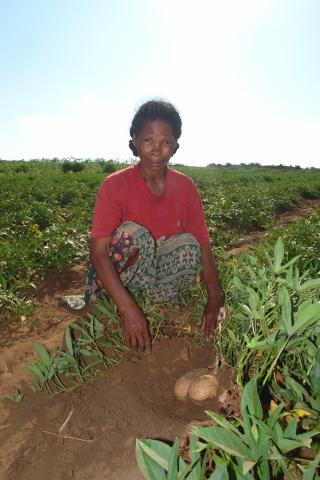Development and delivery of orange sweet potato in Sub-Saharan Africa
Research snapshot1
In sub-Saharan Africa (SSA), more than 40% of children under five years old suffer from vitamin A deficiency. One intervention to tackle this problem is the breeding of vitamin A or beta-carotene (the precursor to vitamin A) into staple crops. The orange sweet potato (OSP) is one such crop that is now used in three million households across SSA. Key to the successful uptake of OSP is that it is liked by target consumers, even in the absence of information about its nutrition benefits. Factors that increase the likelihood of farmers adopting OSP include building an ‘orange brand’ around it; availability of vines to plant; women having influence/control over land; and access to markets. Rates of adoption are increased in households that have regularly consumed white sweet potato in the past. Rapid breeding of OSP varieties was made possible in part by the fact that high levels of beta-carotene exist naturally in many varieties.
Evidence from Mozambique and Uganda shows that an integrated intervention including agriculture (low-cost provision of easy-to-grow OSP), nutrition (broad education and awareness of benefits and use of OSP) and marketing (opportunities to commercialise surplus OSP) positively impacts child vitamin A intakes. The use of OSP in enhanced homestead food production (EHFP) that promotes year-round, nutrition-sensitive agriculture and good nutrition with hygiene practices has also shown positive results in Burkina Faso and Côte d’Ivoire, including reduced levels of anaemia2. The use of OSP in the Mozambique emergency response (drought 2009/2010 followed by floods 2011/2012) was also effective; in just two years a USAID-funded disaster mitigation project, in collaboration with government extension services, reached 134,919 households with new, drought-tolerant varieties of OSP.
The Sweet Potato Profit and Health Initiative (SPHI), launched in 2009, aims to improve the lives of 10 million African households in 17 SSA countries by 2020 through access to OSP. The SPHI has provided an important mechanism for stakeholder engagement so far and continues to play a vital role. Efforts are being intensified to support mainstreaming of OSP into government agriculture and nutrition programmes and to integrate OSP nutrition education into educational institutions to ensure permanent behaviour change.
Footnotes
1Low J, Ball A, Magezi S, Njoku J, Mwanga R, Andrade M, Tomlins K, Dove R and van Mourik T. (2017). Sweet potato development and delivery in sub-Saharan Africa. African Journal of Food, Agriculture, Nutrition and Development, Vol. 17, No. 2, April 2017. https://www.ajfand.net/Volume17/No2/index.html
2OSP is relatively low in phytate compared to other cereals and has high ascorbic acid and fructose, which may improve iron availability.

